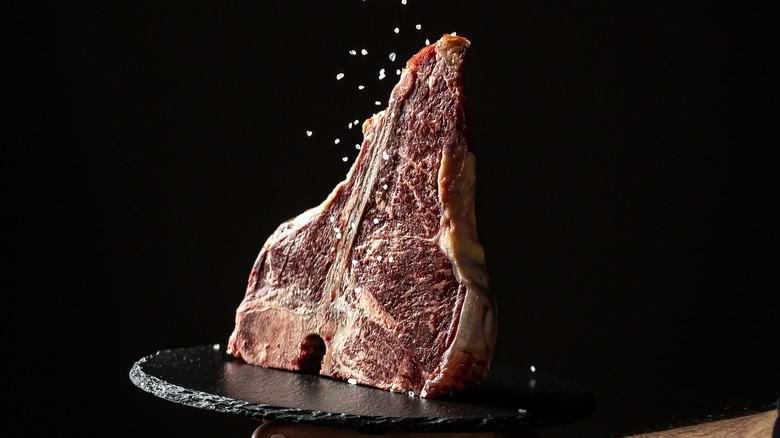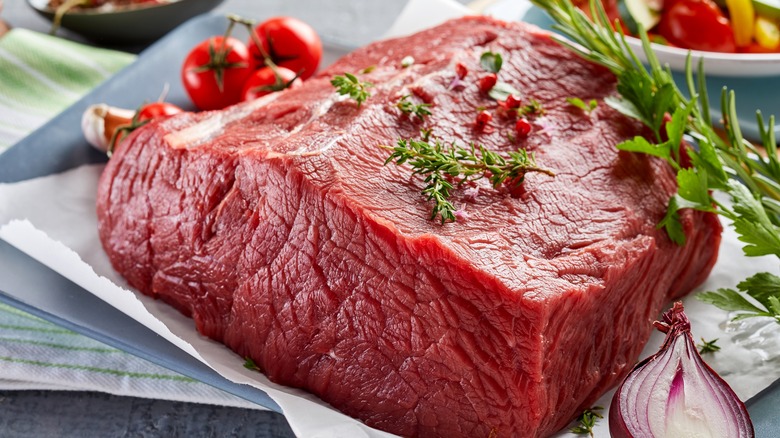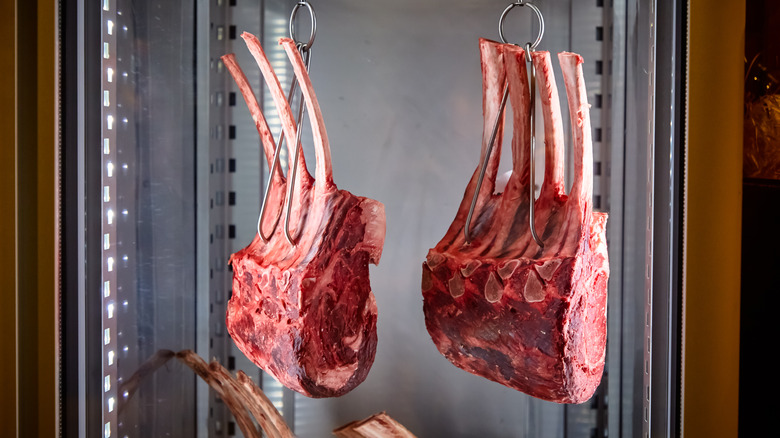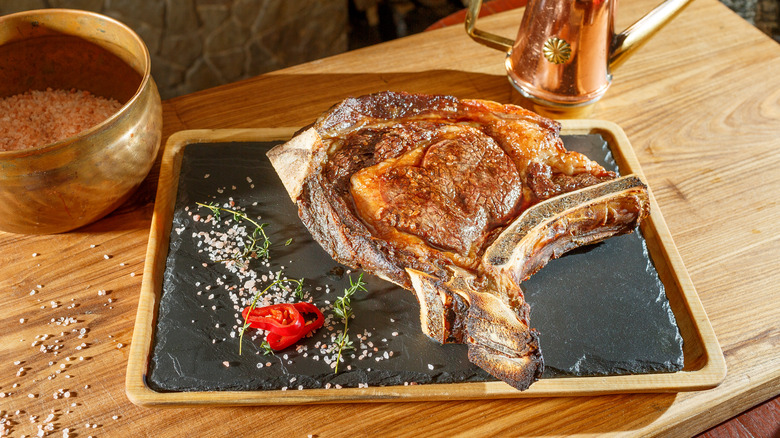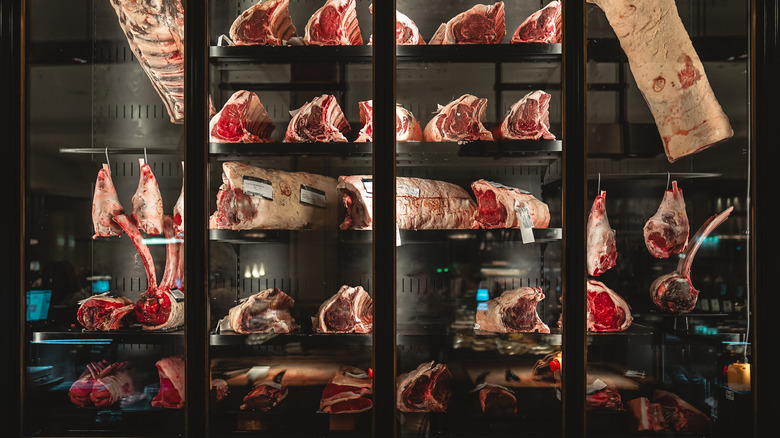What Makes Dry-Aged Beef Unique?
Pick up a menu at a fancy steakhouse and your eyes will likely land on the words "dry-aged". How can meat that is "aged" still be edible and safe to eat? What is the process and why does it make the slice of beef so much more expensive?
When beef is dry-aged, pieces of beef are not simply set on a shelf in the open, there is a careful process that must be followed to age the beef in a safe way. It is not a quick process, a large piece of beef may be left for weeks or months before being divided into steaks and cooked, according to Taste of Home.
As the meat is dry-aged, it loses moisture, and the flavor of the beef is intensified. The combination of time invested and intensified flavor leads to the higher price tag we have come to expect with dry-aged beef. Another attribute of this variety of beef is its tenderness, which occurs when enzymes break down the connective tissue as the meat ages. That all sounds great, but how does one create this perfect balance of flavor and texture?
What is the process for dry-aged beef?
When meat is dry-aged, it is hung in a place where the temperature is maintained, generally around 32 degrees Fahrenheit and 36 degrees Fahrenheit, per The Spruce Eats. The reason the temperature must be kept in that range is so it does not get so warm that it spoils or too cool that it freezes. The air around the meat must also be relatively humid — 85% — so the meat does not dry out.
As the beef is dry-aged, a white mold grows on the exterior of the meat which is cut off after the process is completed, according to Taste of Home. The drying process typically lasts for at least two weeks but can even be done for as long as 120 days. After about two weeks, the texture of the steak begins to get more tender and after three weeks, the flavor begins to alter. At the 30-day mark, the steak gets even more beefy tasting, and if allowed to age for about another two weeks, the meat will start to get a funky, blue-cheese-like taste. The longer the beef is aged, the stronger its taste will get and it will become even more tender.
Can you dry-age beef at home?
Beef can be dry-aged at home, but Taste of Home warns it's not going to be a quick and easy process. The first step is to get the right cut of beef, which should have a higher fat content. The site suggests a large roast, such as rib-eye roast or strip loin. Once you have the meat, then you need to make sure you maintain the right conditions for it to age properly. While you can keep the meat in your refrigerator, it should ideally be a small one that can be controlled easily and set at 40° Fahrenheit. Then, you must make sure you have proper circulation; Taste of Home suggests using a fan.
Then, pat the beef dry and place it on a wire rack over a tray to catch any drippings, per Stanbroke Steak School. This set-up also allows for air to touch all sides of the meat. Try not to check on the meat too often because the more often you open the door, the more the environment changes. If this all sounds a bit too much to bite off, Taste of Home says there is a quick way to create dry-aged beef at home with a fungus called koji. The koji powder is patted on the steak, then the steak is placed in a refrigerator on a wire rack uncovered for 48 hours before cooking.
Dry-aged versus wet-aged beef
There is also a wet method that can be used to age beef and help it to become tender. To wet-age a steak, it is placed in a sealed plastic bag and kept in a refrigerated space for three weeks, per My Chicago Steak. With wet-aging, the meat is tenderized because it is packaged with its juices, which works to break down the connective tissue, per The Spruce Eats.
In the 1960s, wet-aging surpassed dry-aging in popularity because the latter could be completed more quickly, according to Stanbroke Steak School. Another plus was that wet-aged beef was less expensive. There is also more waste with dry-aging beef because the exterior of the meat must be trimmed off before it can be cooked, leaving a smaller portion.
Wet-aging beef isn't an easy feat for the home chef. According to The Urban Baker, it's hard to achieve the correct set-up because humidity levels must be maintained, as well as temperatures. Like dry-aged beef, to successfully wet-age beef, it needs to be kept at a cold temperature, between 28 degrees Fahrenheit and 35 degrees Fahrenheit. There also cannot be any oxygen in the air-tight bag during the process. When it comes to purchasing wet-aged versus dry-aged beef, wet-aged beef is generally cheaper, but the Stanbroke Steak School says it's well worth paying more for the flavor of dry-aged beef.
How to cook dry-aged beef
Simple is best when it comes to seasoning dry-aged beef, according to Dry Ager, who recommends using only salt. Marinades should be avoided because they mask the true flavor of the steak. The beef also needs to be trimmed and prepped for cooking. The Stanbroke Steak School says once it has been dry-aged, the beef will have a crust. That crust needs to be removed, as well as any fat on the outside of the meat, then you can portion the meat into individual steaks.
Cook the steak for about three to five minutes on each side, recommends Taste of Home, until the steak becomes medium-rare. Frying a dry-aged steak is the way to go, contends Dry Ager. By frying the meat, a crisp exterior is formed and the meat takes on a caramelized taste. After the pan has been heated and the fat added for cooking, the steak should be cooked 60 to 90 seconds for each side and then finished in the oven until you reach your desired doneness.
Finally, after letting it rest for about five minutes, grab a knife and fork and slice into the juicy, flavorful piece of beef and enjoy the fruit of your labor.
